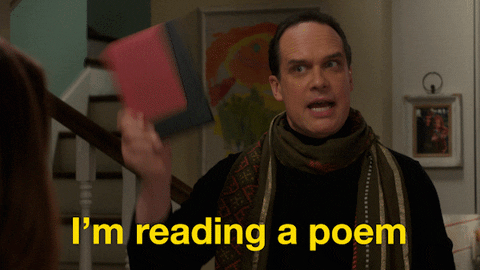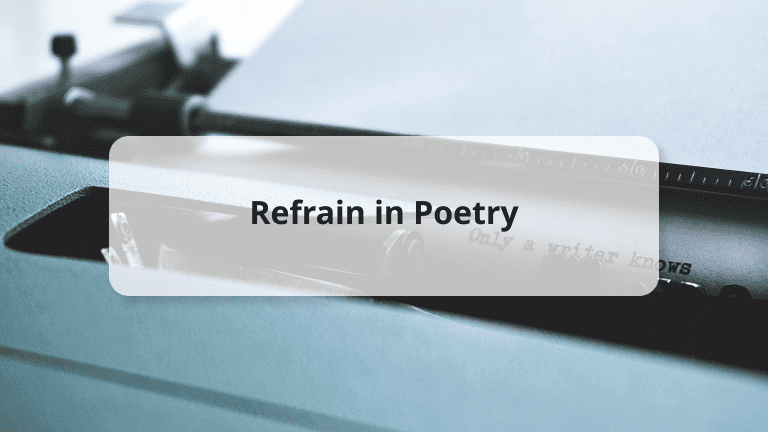Refrain in poetry is a phrase, a line, a set, or a group of lines that appear repeatedly for literary purposes. It is different from “repetition”. Even if you aren’t familiar with the technical term, you’ve probably already encountered this poetic device several times in popular poems and in lyrics to your favorite songs.
Whether you plan to learn English online or you’re already studying composition in advanced English classes, after reading this article you’ll be able to impress your teacher with your knowledge of the refrain poetry definition and recognize its use when you read it.
In this article, we are going to answer the question: “What is a refrain in poetry?” We’ll go through the different kinds of a refrain, why they are used, and how it is different from “repetition.” Finally, we’ll take a look at some famous examples in poetry and music.
The excerpt above is from an Arabic poetic form called a ghazal, which uses a refrain twice in the first couplet and then again in the second line of every couplet that follows. Source: From Call Me Ishmael Tonight by Agha Shahid Ali
Table of Contents
What is a Refrain in Poetry
The refrain literary definition says that it is a phrase, line, or string of words that is repeated at the conclusion of a stanza. It is a poetic device that employs repetition to highlight a particular phrase or theme in a poem. A poem’s distinctive rhyme pattern and distinct rhythm can be enhanced by refrains, which recur at regular or irregular intervals throughout the stanza. A refrain can also be used to play with words with multiple meanings through the changing context of the poem.
Refrains often come in three forms, the repetend, when some words appear again in a poem; the chorus, which is frequently performed together by several readers and occasionally serves as the poem’s central topic; finally, the burden is the most prevalent type of refrain, which involves repeatedly repeating a single word or phrase at regular intervals.

Repetend
A repetend is a repeated single word or short phrase that appears irregularly throughout a poem. These repeated lines or words, or alternating distinct repeated phrases, might add to the rhyme scheme, highlight the theme, or produce an unusual rhythm.
Burden
The burden is the most prevalent type of refrain in which an entire phrase or line is repeated at regular intervals throughout the poem. After appearing several times throughout, the burden is also commonly used to end the poem.
Chorus
A chorus is a phrase or section of lines that is repeated in a poem or song, usually in unison. A chorus frequently accentuates a poem’s topic. When it comes to songs, the phrase refrain may immediately bring to mind the chorus. All choruses are refrains, however, not all refrains are choruses.
Refrains can occur at any moment in a song or poetry. A chorus in music, on the other hand, is a form of refrain that consists of repeated phrases arranged to a specific tune. Lines of a song that are easily remembered are ones that are often repeated, recited, or sung by multiple individuals at the same time.
What is the Function of Refrain in Poetry

Next, we are going to answer the question “What is a refrain used for?”
The role of refrain in poetry varies depending on the poet’s aim, however, it is frequently employed to place emphasis and rhythm.
For rhyming
Refrains can add to a poem’s rhyme scheme. The poem below is a villanelle that uses the refrain “The art of losing isn’t hard to master” and a repetend of the word “disaster” for the rhyme scheme: aba aba aba aba aba abaa.
One Art BY ELIZABETH BISHOP
The art of losing isn’t hard to master; so many things seem filled with the intent to be lost that their loss is no disaster. Lose something every day. Accept the fluster of lost door keys, the hour badly spent. The art of losing isn’t hard to master. Then practice losing farther, losing faster: places, and names, and where it was you meant to travel. None of these will bring disaster. I lost my mother’s watch. And look! my last, or next-to-last, of three loved houses went. The art of losing isn’t hard to master. I lost two cities, lovely ones. And, vaster, some realms I owned, two rivers, a continent. I miss them, but it wasn’t a disaster. Even losing you (the joking voice, a gesture I love) I shan’t have lied. It’s evident the art of losing’s not too hard to master though it may look like (Write it!) like disaster.
Emphatic purpose
Repetition helps a reader recognize an idea, so poets can employ refrain to emphasize a certain idea. This excerpt from Robert Frost’s poem repeats the final line “and miles to go before I sleep,” to emphasize the sheer distance remaining in the persona’s journey.
Stopping by Woods on a Snowy Evening BY ROBERT FROST
[...]
The woods are lovely, dark and deep,
But I have promises to keep,
And miles to go before I sleep,
And miles to go before I sleep. (Lines 13-16)
Difference between Repetition and Refrain in Poetry
The word refrain is derived from the French “refraindre”. Refrain literally means “to repeat.” Refrain is a form of repetition, as a literary device, refrain is repetition that specifically occurs in song and poetry. Repetition can occur in anything from prose and fiction to an ordinary conversation or a comedy sketch. Martin Luther King, Jr.’s “I Have a Dream Speech” is an example of the use of repetition that isn’t a refrain. He emphasizes the statement “I have a dream” by repeating it several times.
Famous Examples of Refrain in Poetry
You may think poetry is something reserved for intellectuals or people who grew up with Robin William’s Dead Poet’s Society character Mr. John Keating as a teacher, but in reality, you might recognize more of it than you think. Let’s take a look at some famous examples of refrain in both poetry and song.
Repetend
Example 1: Our first example is the use of repetend in From Maud (Part I) by Alfred Lord Tennyson, an eleven-stanza poem from his work Maud, which is a longer poem in the form of a dramatic monologue made up of 27 different lyric poems.
The excerpt here describes the “planet of Love” Venus, which is currently visible high in the sky over the speaker’s head. However, the planet’s brightness is fading as the morning approaches.
The speaker incorporates themes of love, grief, and death while discussing the interaction between Venus and the Sun as the former’s light is drowned out by the brightness of the latter. The repetend “to faint in the light” and later to “faint in his light ”takes on different meanings in the poem. (to faint = to lose consciousness, to swoon, to be reduced in brightness, to die). Here we have an example from stanza two of Maud.
Maud (Part I) BY ALFRED, LORD TENNYSON
[...]
For a breeze of morning moves,
And the planet of Love is on high,
Beginning to faint in the light that she loves
On a bed of daffodil sky,
To faint in the light of the sun she loves,
To faint in his light, and to die. [...](Lines 7-1)
Example 2: T. S. Eliot’s The Love Song of J. Alfred Prufrock presents an inner monologue in the life of the titular persona. Prufrock is a manic yet rigid middle-aged man that is alienated from the world and its inhabitants by his own indecisiveness. The repetend “Do I dare?” from the excerpt demonstrates his ongoing indecision and dread that prevent him from acting on his concerns about what might occur if he actively tried to change himself or the world around him.
The Love Song of J. Alfred Prufrock BY T.S. ELIOT
[...]
And indeed there will be time
To wonder, “Do I dare?” and, “Do I dare?”
Time to turn back and descend the stair,
With a bald spot in the middle of my hair —
(They will say: “How his hair is growing thin!”)
My morning coat, my collar mounting firmly to the chin,
My necktie rich and modest, but asserted by a simple pin —
(They will say: “But how his arms and legs are thin!”)
Do I dare
Disturb the universe?
In a minute there is time
For decisions and revisions which a minute will reverse [...](Lines 37-48)
Burden
Example 1: “Do not go gentle into that good night” is about a child unable to come to terms with his father’s demise. The poem’s opening line, already a repetition of its title, is used as a burden. Dylan Thomas utilizes the night as a metaphor for dying and laments his father’s “gentle” acceptance of it. He beseeches his father to “rage, rage against the dying of the light,” — the other burden, referring to the arrival of night, or, as it is interpreted here, death.
You may recognize this poem as read in Michael Caine’s voice from the Christopher Nolan sci-fi epic Interstellar, which imbues the poem with a new layer of meaning as a motivational message to humanity to persevere and live on in the face of impending apocalypse as the Earth is plagued by blight and dust storms.
Do not go gentle into that good night BY DYLAN THOMAS
Do not go gentle into that good night,
Old age should burn and rave at close of day;
Rage, rage against the dying of the light.
Though wise men at their end know dark is right,
Because their words had forked no lightning they
Do not go gentle into that good night.
Good men, the last wave by, crying how bright
Their frail deeds might have danced in a green bay,
Rage, rage against the dying of the light.
Wild men who caught and sang the sun in flight,
And learn, too late, they grieved it on its way,
Do not go gentle into that good night.
Grave men, near death, who see with blinding sight
Blind eyes could blaze like meteors and be gay,
Rage, rage against the dying of the light.
And you, my father, there on the sad height,
Curse, bless, me now with your fierce tears, I pray.
Do not go gentle into that good night.
Rage, rage against the dying of the light.
Example 2: Howl, sometimes called “Howl for Carl Solomon,” is a poem by Allen Ginsberg written in 1954–1955. It was first published in his 1956 book Howl and Other Poems. The persona in the excerpt below is expressing his love and support for fellow American author Carl Solomon, who is a patient at the mental hospital referred to as “Rockland.”
Instead of abstractly thinking about refrain as a tool of emphasis. You can think of it like the difference between saying “I love you” and saying “I love you! I love you! I love you!” In the case of Howl, the burden “I’m with you in Rockland” is repeated 19 times in the full poem, which shows an overwhelming display of solidarity for his friend.
Part III of Howl BY ALLEN GINSBERG
III.
Carl Solomon! I'm with you in Rockland
where you're madder than I am
I'm with you in Rockland
where you must feel very strange
I'm with you in Rockland
where you imitate the sahde of my mother
I'm with you in Rockland
where you've murdered your twelve secretaries
I'm with you in Rockland
where you laugh at this invisible humor
I'm with you in Rockland
where we are great writers on the same dreadful typewriter[...](Lines 1-12)
Chorus
Example 1: The first half of this Copacabana’s narrative, which is about the showgirl Lola and her bartender boyfriend Tony, follows the song’s upbeat tune. However, in the second part, once Tony is fatally shot, the narrative takes a tragic turn, and Lola is discovered to be mad and depressed 30 years later.
The chorus in this song, despite having mostly the same words, changes according to the context of the story. The focus on the upbeat and bright location serves as an interesting juxtaposition to the darkness of the events that transpire. Each repetition is punctuated by small but profoundly different phrases on the word love to reflect the tragic changes that happen to the Lola character.
Copacabana (At the Copa) BY BARRY MANILOW
Her name was Lola, she was a showgirl
With yellow feathers in her hair
And a dress cut down to there
She would merengue and do the cha-cha
And while she tried to be a star
Tony always tended bar
Across the crowded floor
They worked from eight 'til four
They were young and they had each other
Who could ask for more?
At the Copa, Copacabana (Copa, Copacabana)
The hottest spot north of Havana (Here)
At the Copa, Copacabana (Copacabana)
Music and passion were always the fashion
At the Copa, they fell in love (Copa, Copacabana)
His name was Rico, he wore a diamond
He was escorted to his chair
He saw Lola dancing there
And when she finished, he called her over
But Rico went a bit too far
Tony sailed across the bar
And then the punches flew
And chairs were smashed in two
There was blood and a single gunshot
But just who shot who?
At the Copa, Copacabana (Copa, Copacabana)
The hottest spot north of Havana (Here)
At the Copa, Copacabana (Copacabana)
Music and passion were always the fashion
At the Copa, she lost her love (Copa, Copacabana)
(Copa, Copacabana, Copacabana
Music and passion, always in fashion)
Her name is Lola, she was a showgirl
But that was thirty years ago
When they used to have a show
Now it's a disco, but not for Lola
Still in the dress she used to wear
Faded feathers in her hair
She sits there so refined
And drinks herself half-blind
She lost her youth and she lost her Tony
Now she's lost her mind
At the Copa, Copacabana (Copa, Copacabana)
The hottest spot north of Havana (Here)
At the Copa, Copacabana (Copacabana)
Music and passion were always the fashion
At the Copa, don't fall in love
(Copa, Copacabana) Don't fall in love
(Copacabana, Copacabana)
Example 2: “I See a Darkness”’ is a song by Will Oldham famously covered by the great Johnny Cash. The poem is a verbal plea for friendship and support from the point of view of somebody trying to be or do better in the world and constantly failing. The titular “darkness” in this poem can refer to multiple things. Some have interpreted it as evil, loneliness, depression, or even sickness and death.
The first few stanzas start with the persona baring their soul before getting to the first chorus where the line “And that I see a darkness” is repeated four times (refrains within a refrain) to emphasize how troubling this “darkness” is to him. In the following verse, the persona expresses his hope to “pull the smiles inside/ and light it up forever” before being undercut by the chorus coming back with a more ominous “Oh no, I see a darkness.”
I See a Darkness BY WILL OLDHAM
Well, you're my friend
(It’s what you told me anyway)
And can you see
(What’s inside of me)
Many times we've been out drinking
Many times we've shared our thoughts
But did you ever, ever notice
The kind of thoughts I got?
Well, you know I have a love
A love for everyone I know
And you know I have a drive
To live, I won't let go
Could you see this opposition
Comes rising up sometimes?
That it's dreadful imposition
Comes blacking in my mind
And then I see a darkness
And then I see a darkness
And then I see a darkness
And then I see a darkness
Did you know how much I love you?
Is a hope that somehow you
Would save me from this darkness
Well, I hope that someday, buddy
We have peace in our lives
Together or apart
Alone or with our wives
And we can stop our whoring
And pull the smiles inside
And light it up forever
And never go to sleep
My best unbeaten brother
This isn't all I see
Oh no, I see a darkness
Oh no, I see a darkness
Oh no, I see a darkness
Oh no, I see a darkness
Did you know how much I love you?
Is a hope that somehow you
Would save me from this darkness
The refrain literary definition says that it is a phrase, line, or string of words that is repeated at the conclusion of a stanza. It is a poetic feature that uses repetition to highlight a special phrase or theme in a poem. A poem’s unique rhyme pattern and distinct rhythm can be enhanced by refrains.
Refrain is a form of repetition, as a literary device, refrain is repetition that specifically occurs in song and poetry. Repetition can occur in anything from prose and fiction to an ordinary conversation or a comedy sketch.
Refrain is very common to see in a poem. There are different types of refrains. For Chorus type of refrain, see Copacabana (At the Copa) BY BARRY MANILOW.
Ready to show off your writing skills?

There you have it. Now you should be able to identify refrains when they are used in both poems and songs. To take it a step further, why don’t you try and demonstrate this newfound knowledge by incorporating refrains into your writing? Try coming up with a poem or a song that uses all three kinds of refrain and don’t be afraid to share it with people to get feedback.
A good writer is also a good reader. So make sure you get enough reading and writing practice to improve your skills. If you want to become a better writer, you can take online writing courses or follow our tips on how to learn English.
Check out AmazingTalker to learn more about language and culture not just in English but also in a range of other fascinating languages from our partnered tutors!

















